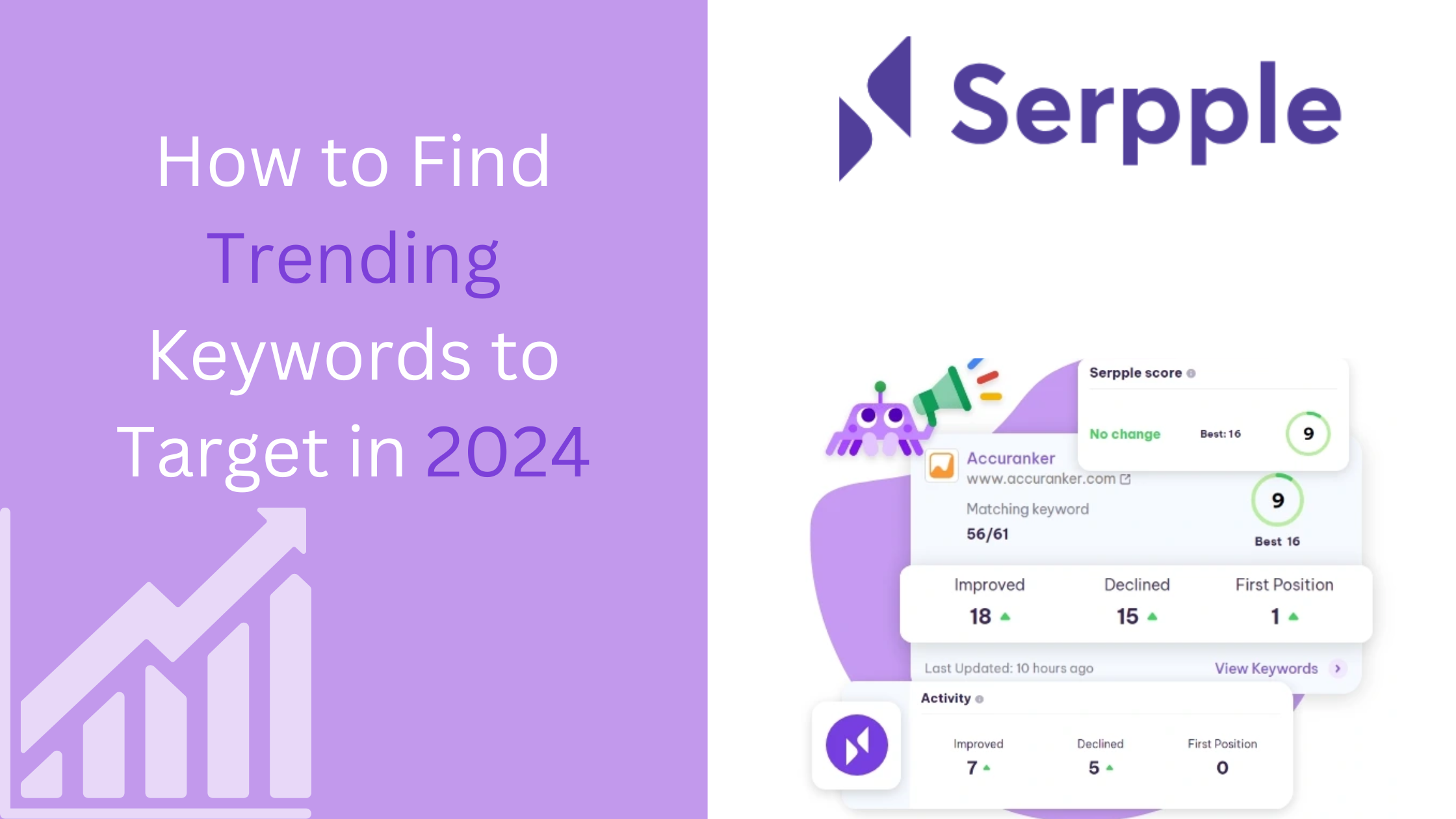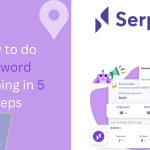
Trending keywords are like new cryptocurrencies – the early birds get the worm.
The easy route is to optimize for keywords that are already well-known, and most of your competitors rank for – but what truly makes a difference, based on my experience, are those trendy keywords you catch early on and rank higher on Google.
Discovering trending keywords before they become “trendy” requires research and experimentation. However, SEO experts have discovered that the benefits of ranking early for a trendy keyword and directing the sudden wave of traffic towards your website outweigh the effort it takes to find these hidden jewels.
Therefore, in this article we will show step-by-step how you can find trending keywords for your niche manually and with a super cool Ahrefs alternative (free trial included).
Table of Contents
How to find trending keywords manually
Before SEO tools and data that do the heavy lifting for me, I used this exact framework to find new opportunities for my brands.
- Identify potential keywords, my first step is to brainstorm ideas that are relevant to my niche or industry. For this, nowadays, you can use ChatGPT, here is a great prompt:

2. Use the short keywords to find long keywords. Google Autocomplete is an excellent tool, showing potential search queries as I begin typing in the Google search bar. It reflects what users commonly search for, which helps me understand user intent. Make sure to regularly check this, as Google updates it:

3. I also look at the related searches at the bottom of Google’s search results page. These are queries that are associated with the original search term, broadening my scope of possible trending keywords.

4. Tracking Google Trends gives me insights into the popularity of specific search terms over time. It’s particularly useful for finding trending keywords because I can see the trajectory of a keyword’s search volume, which can indicate rising interest. You can also set an alarm on Google alerts to get notifications of new keywords and topics showing up.

5. Social media platforms are sources of real-time user engagement and can highlight trending topics. I monitor platforms like Twitter, Reddit, and LinkedIn to see what people are discussing actively. Don’t skip on them and make a common SEO mistake.
Bonus tip: By participating in these discussions actively, you can subtly promote your brand. The engagement may be low, but they are all high-intent readers. Use relevant hashtags for your niche to find discussions. For example, if you are in the SaaS niche, check:
- Upcoming regulations
- Legislation that impacts your industry
- Politics
- The economy
- Cultural events

6. Lastly, I consider internal data from my own content to see which topics or keywords are performing well. This involves looking at metrics like page views and search rankings to find trending keywords that have already brought traffic to my site.
I used Serpple because it has all the data I need (but you can use Google Search Console, GA4, etc). For keywords that perform well, I try to find a new angle, a more specific or broader term, a similar or connected keywords I didn’t cover etc.
Also, if your customer support has some internal customer data, dig deep to find the “language” they are using to describe their needs and problems – you might end up googling keywords in their specific order or using words you would never have thought of on your own.

Combining these manual methods sets a strong foundation for my long-tail keyword research. It’s essential to remember that trends change, so I make it a practice to revisit and revise my keyword list regularly.
However, remember that the time you spend on research is just the beginning. You need to set aside time to properly “make use” of these keywords and not let them go to waste.
Learn more about streamlining the research process with Serpple or how to use trending keywords below.
How to find trending keywords faster (with Serpple)
It used to take me days to discover trendy keywords because finding them for many highly competitive niches isn’t easy. With Serpple, everything is automatized – and I only need to act on new information fast.
The best part? You can set email triggers to receive alerts when specific changes or improvements are required, ensuring they stay on top of your SEO strategy.
Here’s how I streamline the process:
- Add Domains and Keywords: I begin by adding my website to Serpple, which allows me to monitor keyword rankings on Google effectively. You can check keywords right away with a free trial.

Enter a keyword and choose the region for which you want to do keyword research.

Once you are set, here are the features that will help you predict future trends:
- Keyword opportunities
- Search volume rise and drop
- Competitor AI feature
Before going into details about each feature, I must mention that Serppledaily Google ranking updates with an impressive accuracy rate of 99.9%. Users can rely on up-to-date data to make informed decisions. Here is an in-depth overview of the 3 features:
Keyword opportunities feature

The “Keyword Opportunities” tab on the left is the first step towards finding the trending keywords you should use for your website.
Click on “Find new opportunities”

2. Choose between your GSC, Google AdWords or Google Search to discover impactful keywords:

3. Start tracking those trending keywords or use them for other purposes:

4. Filtering options are particularly beneficial; they let me refine the list based on:
- Average volume
- Competition level
- Monthly search volume
Serpple shows auto-complete predictions and related searches data, so you don’t need to look into that separately.
Evaluating key metrics, such as SERP positions and the volume of Google search results for each keyword, further ensures that I know each keyword’s potential. This level of detail is crucial for understanding the ‘what,’ and the ‘why’ behind keyword success.
This feature, overall, acts as a strategic compass for trending keywords, but it isn’t the only north star I use from Serpple.
Search volume rise and drop feature

Understanding the fluctuations in search volume for keywords is crucial for my SEO strategies. I always focus on identifying which keywords are gaining popularity and which are losing traction.
With this feature, I regularly track relevant keywords for my niche and monitor potential trending opportunities and low-hanging fruit keywords. A fast and effective way to have “all eggs in one basket” and never miss a chance.
Don’t skip on this and make a common SEO mistake.
What I gain from the insights
- Prioritization: I use the trend information to prioritize keywords that are becoming more popular, thereby staying ahead of the competition.
- Content strategy: If I notice a keyword declining, I may focus on alternative phrases or revamp my content to align with rising keywords.

By actively engaging with the Search Volume Rise and Drop feature and Improved/Declined rankings I maintain a dynamic and responsive approach to SEO. Understanding these patterns helps me tailor my strategies to what users are currently searching for, optimizing my online presence.
Competitor AI feature

The Competitor AI feature gives a comprehensive analysis of how your SERP rivals are performing online. Just add your top competitors (you will find them when you google your target keywords that best describe your brand).
On my dashboard, I immediately see a snapshot of my competition. This includes their keyword strategies and performance metrics. The option to ‘Add competitor’ is prominently displayed, so I can expand my monitoring to include any new entries I need to watch.

Viewing Keywords of these competitors offers deeper insights. Here’s what I focus on:
- Competitors’ targeted keywords: Identifying which terms they are investing in.
- Traffic generation: Evaluating how these keywords are enhancing their online presence.
- Content relevance: Understanding the alignment of their content with trending searches.
This detailed information empowers me to spot untapped keyword opportunities and to understand the nuances of competitive advantage. The detailed SEO competitor analysis helps me make informed decisions to optimize my content strategy accordingly.
With Competitor AI, I’m not just reacting to the market—I’m proactively strategizing to lead in my niche.
What to do with trending keywords
Once you’ve identified trending keywords with and without the help of a tool, the next big step is integrating them into your content strategy.
Incorporate into new content:
- I create fresh, informative content tailored around trending keywords. Plus I add (naturally) these keywords into subheadings, image ALT tags, metadata etc.
- Videos, blog posts, and articles about these hot topics are excellent for driving relevant traffic. Make sure to double check the intent of your target keywords to make sure you are creating relevant content for your audience.
Refresh existing content:
I revisit my published work and weave in trending keywords where fitting. For example, once the new content is published, I use the trending keyword as an anchor for internal link building (the best internal link building strategies focus on clusters/pillar articles) If you are also doing link building, this could be a very hot anchor on someone elses’ website.
I optimize my website copy and URLs if I find that the target keywords will bring valuable traffic. For example, in the era of ChatGPT, websites that ranked for “ChatGPT alternatives” caught the first wave of dissatisfied users,looking for other similar tools.
Engage on social platforms:
I share my content on social media, and include the trendy keywords as hashtags in case some discussions around them start to rise up. LinkedIn and Quora are my go-to places, but it all depends on the niche you are in. As I mentioned above these discussions bring in a lot of high intent traffic so make sure to engage with the right communities and share links to your content.
Seasonal fluctuations in search trends also impact my update schedule, as I aim to optimize my website’s pages with seasonal keywords trends for the best performance.
Implementing these strategies has made a marked difference in my viewer engagement and search engine rankings, as detailed in this how to track search engine rankings guide. My main keyword placements are now more strategic, resulting in content that not only captures trending interest but also serves my audience’s needs.
Conclusion
I hope this article gave you some new insights and on how, when and why you should track trending keywords. I believe that all brands with proven results use trending keywords in one way or the other.
If you don’t want to spend hours and days on this process, Serpple will be your SEO assistant.
With Serpple, you can do keyword research, competitor analysis, SEO content audits, keyword groupings, white-label ranking reports – all in one single dashboard with dynamic graphs and up-to-date data.
No more hours of manual work and juggling between different tools and platforms. Start a 14-day free trial and discover the trending keywords for your industry.
FAQs
The first step to uncovering the most popular keywords is to utilize tools such as Google Keyword Planner. This free tool, accessible via a Google Ads account, provides insights into search volume and competition for keywords related to your content. Additionally, Google Search Console can reveal queries that are already bringing traffic to your site, highlighting potential new keywords to target. Or you can use Serpple and monitor trending keywords in one platform.
Trending keywords are terms that have seen a recent spike in search volume. They signify topics currently popular or becoming popular among users across Google Ads, social media, and other search engines. Recognizing such keywords can be greatly advantageous for timely and relevant content creation.
Capturing trending keywords is crucial because it allows you to align your content with what your audience is actively searching for. This can lead to increased visibility and higher organic search rankings. Plususing a keyword research tool can streamline the process of identifying these valuable terms, making it easier to find keywords that can drive traffic and engagement.
Adam White
Posted on March 28, 2024
Adam White is a 20+ year SEO professional who has optimized over 400 websites, built and sold over 20 internet and SaaS businesses all with SEO as the main traffic source. Follow him on Twitter/X



